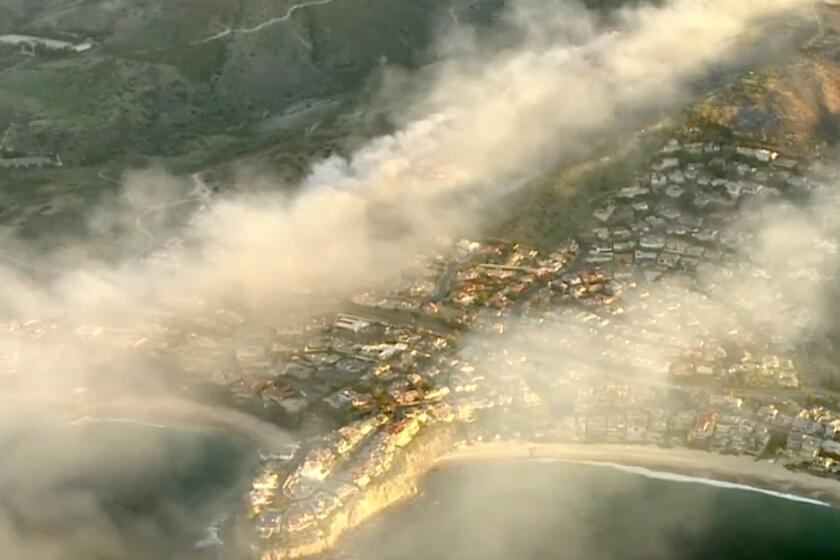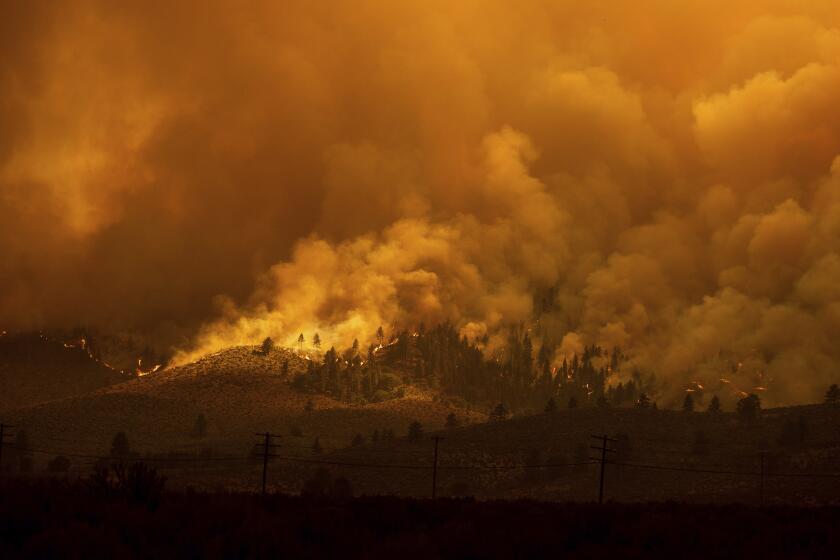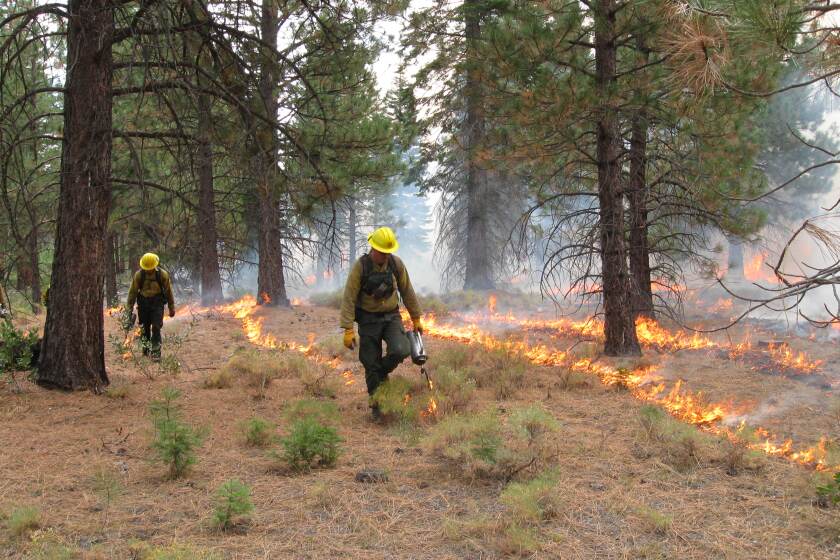‘We no longer have a fire season. We have a fire year.’ Heat, winds fuel two winter blazes in Southern California

The fire broke out around 4 a.m. in a wilderness area between Laguna Beach and Emerald Bay near Coast Highway.
Driven by unseasonable heat and gusty Santa Ana winds, two Southern California fires Thursday brought acrid smoke, evacuation orders and flaming fronts — harbingers of a difficult fire year for the parched region.
In Orange County, residents of an affluent community awoke to evacuations spurred by the Emerald fire. No homes were damaged, but authorities warned that ideal fire conditions were expected to persist through the weekend.
And they also worried about what the coming months could bring.
“We no longer have a fire season. We have a fire year,” Orange County Fire Authority Chief Brian Fennessy said. “This is supposed to be the middle of winter, and we’re anticipating 80- to 90-degree weather. Even though the hillsides are green, it doesn’t take but low humidity and wind to cause fires to occur.”
“If this is any sign of what’s to come throughout the rest of the winter and spring, we’re in for a long year,” Fennessy added.
As crews worked to contain the blaze Thursday afternoon, a fire erupted near Whittier.
Los Angeles County firefighters were able to keep the Sycamore fire to 7 acres, but flames destroyed two homes and damaged another. One person was taken to a hospital with non-life-threatening burns, authorities said.
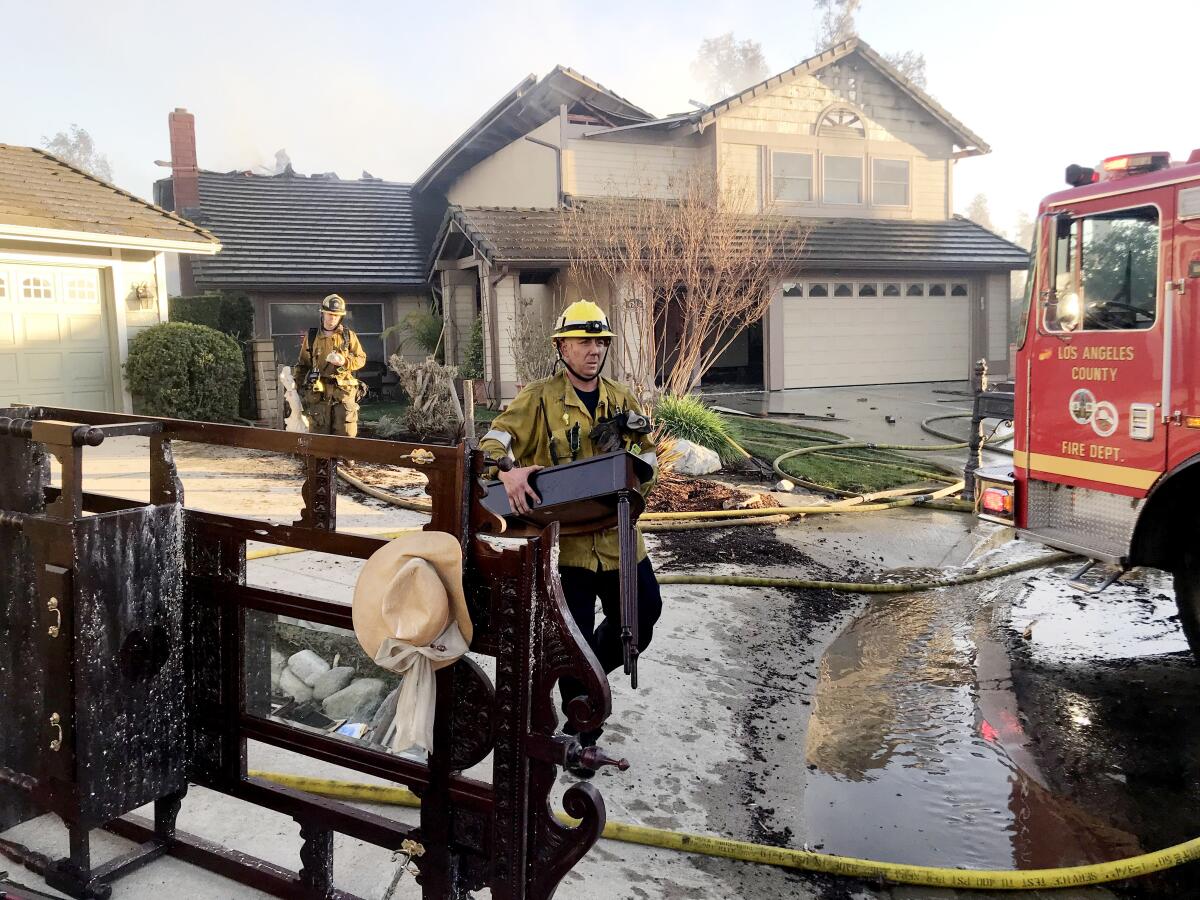
Inspector Sean Ferguson, an L.A. County Fire Department spokesman, said Thursday evening that the fire was 20% contained and that crews had halted its forward progress, with more than 200 firefighters battling the blaze.
Firefighters faced hot and dry conditions, with temperatures in the 80s, 10-mph wind gusts and 18% humidity in the area, according to the National Weather Service.
In Orange County, similar conditions challenged crews fighting the Emerald fire, which broke out around 4 a.m. in the wilderness area between Laguna Beach and Emerald Bay near Coast Highway.
Thick clouds of smoke blanketed the entire beachside town as residents from Irvine Cove and Emerald Bay, two gated communities with sweeping views of the Pacific Ocean, packed up their cars and fled in the dark.
Minutes earlier, dozens of Orange County sheriff’s deputies had raced to the neighborhoods to wake sleeping residents and urge them to leave. Deputies made announcements via loudspeaker from their patrol cars and knocked on doors as the ridgeline above the neighborhoods glistened.
Some looked out their windows to see the red glow of flames charging toward them. Santa Ana winds were gusting up to 40 mph when the first flames were spotted, officials said.
Irvine Cove, Emerald Bay are under an evacuation order from a brush fire. North Laguna is under an evacuation warning. Coast Highway is closed.
Evacuation orders for Emerald Bay and Irvine Cove were lifted at 3 p.m., but residents should be prepared to evacuate again if needed, Laguna Beach Fire Chief Mike Garcia said.
“Just because they’re lifted doesn’t mean it’s completely safe,” Garcia said. “This week we’re going to have some high heat. We’re going to have a little wind. Fire weather exists, and it’s going to continue through the weekend.”
The Emerald fire charred 145 acres and was 20% contained Thursday night, said Capt. Paul Holaday, a Fire Authority spokesman.
The fire hadn’t grown since Thursday morning, and crews would remain on site overnight to increase containment, Holaday said.
Authorities had 220 personnel fighting the fire at its peak, including eight strike teams and multiple firefighting helicopters and fixed-wing aircraft.
Holaday said firefighters would be working “probably through the weekend” on tactical patrols through the neighborhoods to watch for hot spots and flare-ups.
Hand crews would continue to work the line Thursday, with efforts ramping up Friday morning, he said.
Although the blaze appeared to be out when viewed from Coast Highway, areas of the backcountry were still burning, Holaday said.
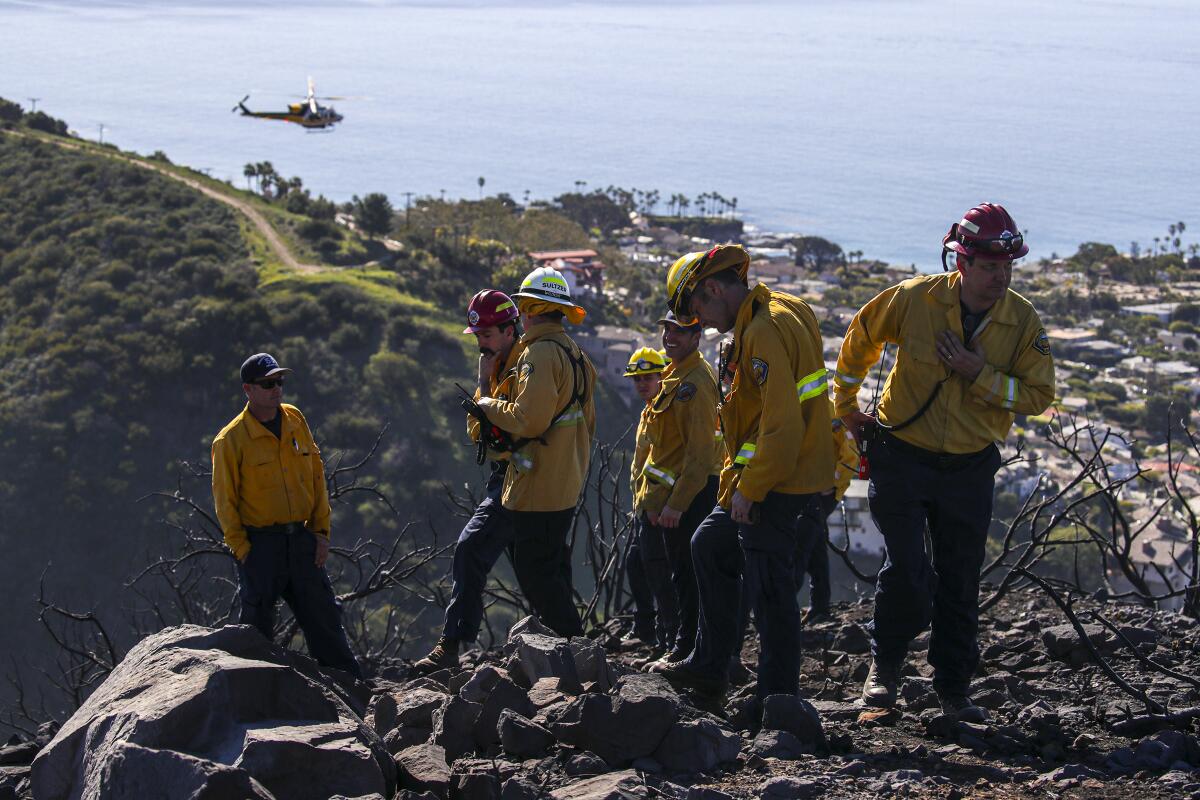
Officials said the fire underscores that dangerous blazes can erupt outside California’s traditional fire season, which typically begins late summer or early fall.
A string of powerful storms swept across the Golden State in December, refilling reservoirs, restoring the snowpack and bringing an end to a 2021 fire season that shocked fire crews with unprecedented behavior.
For the first time, wildfires burned from one side of the Sierra Nevada to the other, destroying multiple towns including the Gold Rush-era community of Greenville and the mountain hamlet of Grizzly Flats.
The reprieve, it seems, was short-lived.
February, which is traditionally the wettest month in California, has been witheringly dry. Coastal Orange County hasn’t had significant rain since late December.
Drier-than-normal brush paired with low humidity and temperatures in the high 80s created conditions that drastically raised fire risk on Thursday, officials said.
“We don’t even have a marine layer,” said Samantha Connolly, a meteorologist with the National Weather Service in San Diego.
The dryness of the vegetation, primed by both long-term drought and shorter-term heat waves, is making it easy for fires to ignite and even easier for them to spread.
In Orange County, crews focused on protecting Emerald Bay and Irvine Cove, home to some of the most expensive real estate in the county. Billionaire Warren Buffett owned homes in Emerald Bay.
City Councilman George Weiss was standing in an empty lot in north Laguna Beach just before 6 a.m. consulting with firefighters about their plan of attack. He could hear evacuation messages being broadcast over loudspeakers to residents, urging them to leave quickly.
At the time, he feared the worst.
Strong winds pushed flames toward the multimillion-dollar homes before sunrise, but by midmorning had died down enough for firefighters to boost containment and stop the blaze’s momentum.
Mayor Sue Kempf said many longtime residents still have vivid memories of a massive wildfire that tore through the city in 1993, damaging more than 400 homes. The Laguna fire, which started in the canyon and spread to Emerald Bay before burning to the ocean, was one of the most devastating blazes in Orange County history.
It also prompted city officials to impose restrictions on home renovations and new construction, banning shake shingle roofs and requiring automatic sprinkler systems.
“People have been here a long time, and they’re very sensitive. They’re very worried,” Kempf said. “I think we have a good team working on this. I’m confident we’ll get through this.”
Fire officials applauded residents for cutting back vegetation to create “defensible space” around their homes, allowing crews to better protect their properties.
Even as evidence mounts that prescribed burns are effective in reducing wildfire risk, the U.S. Forest Service and other agencies are falling behind.
Emerald Bay Service District General Manager Mike Dunbar hadn’t heard about the fire when he left his home in Tustin shortly after 7 a.m. to drive to his office in Emerald Bay. He thought it was strange that Coast Highway was closed. Then he saw the smoke.
The streets in the neighborhood, which are typically busy with activity even during the week, had fallen silent.
“It’s like a deserted city,” he said.
About three miles north of the fire at Crystal Cove Beach Cottages, Eulynn Gargano woke up early to watch the sunrise at the beach when she noticed the sky looked a bit odd.
“Oh, look, the clouds are rolling in,” she told her partner, John Cullen, who was vacationing with her.
She thought it was the marine layer coming in, but it looked too dense. Cullen, who lives in New York, stepped outside wanting to capture the sunrise with his camera. Then they saw smoke and got news about a fire nearby.
Gargano, who splits her time between New York and Huntington Beach, said she wasn’t too worried. Cullen snapped photos of the smoky pink sky with his camera perched on top of a tripod, facing south.
Helicopters hovered above the crashing waves. The rough winds whipped palm trees just steps away, but the couple said they wouldn’t evacuate unless it became mandatory. They lucked out, with Crystal Cove being just outside the evacuation zone, they said.
Most of the smoke had cleared at Crystal Cove State Beach by 8:30 a.m. A toddler danced near the shore. A woman sipped her coffee while gazing at the crashing waves. An elderly man jogged nearby.
Cole Daroff and his 3-year-old daughter, Eloise, carved shapes in the sand with sticks. Daroff’s wife, Margaret Burris, set down a pair of cinnamon rolls on their beach blanket.
The only hint that anything was amiss was the helicopters in the sky. But that didn’t seem to bother them.
“We live in L.A.,” Burris said. “There are helicopters over our house all the time.”
More to Read
Sign up for Essential California
The most important California stories and recommendations in your inbox every morning.
You may occasionally receive promotional content from the Los Angeles Times.
